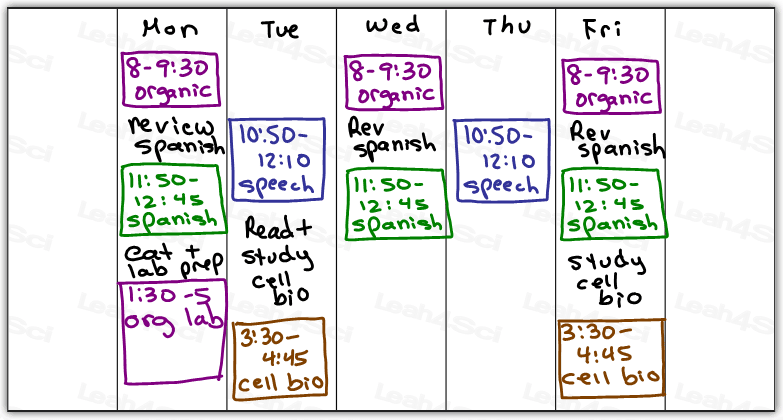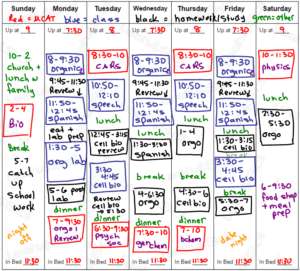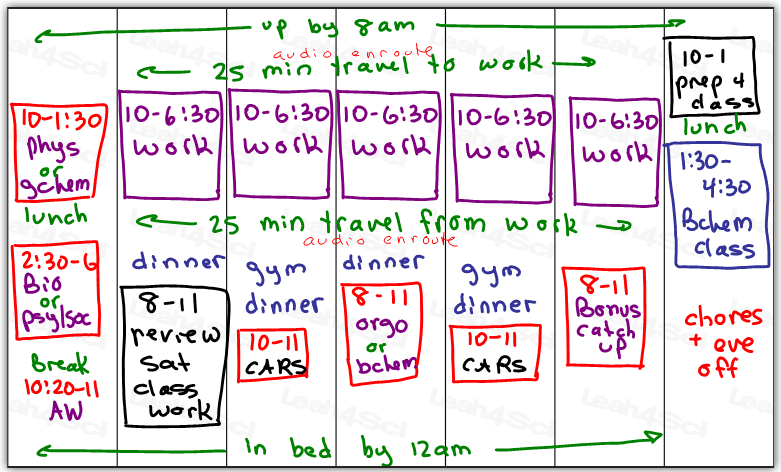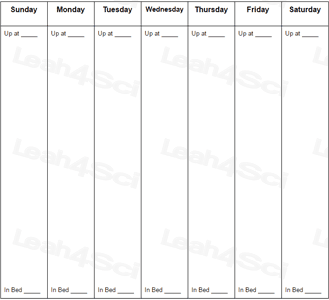At this point in the Guide, you should understand the MCAT (Step 1), have begun personalizing your Guide Companion Workbook with your dream school and target score (Step 2), and assembled all of your MCAT resources (Step 3).
Stumbled onto the Ultimate MCAT Prep Guide? Click to Start at the Beginning.
Are you ready to move forward?
If you haven’t done the above, you may need to go back and be sure you’re ready to begin creating your study schedule.
How do you start?
Do you start by just reading every MCAT prep book and watching every video?
Not quite!
A proper MCAT schedule focuses on three components.
- WHEN you’re going to study on a daily/weekly basis
- How LONG you’re going to study overall
- WHAT you’re going to study
So you’re studying for the MCAT?
Oh, then you’re a twenty-one year old junior with perfect grades and an easy semester. You’re living with a supportive parent and have zero non-academic responsibilities to distract you from your upcoming MCAT studies… right??
Oh wait. This guide isn’t fiction.
Chances are you’re not twenty-one with perfect grades, and you have a million distractions pulling you from all sides away from the MCAT:
school, work, life, friends, family, maybe physical limitations, and more.
So let’s figure out, realistically, when you can carve out time from your busy schedule to study!
If you’re like one of my students, a single mom with a toddler to keep up with, chances are you’re not getting any quality studying time when your child is running around all day.
If you have an older (less dependent) child, and a supportive spouse like this student, you’ll be able to carve out more time during the day.
But no matter what your life looks like, you’ll still need to find a way to balance your MCAT studying with everything else that is going on.
You can’t explain to your children, or even your loving pets, that there won’t be any food in the house for the next five months because mommy/daddy has to study for the MCAT!
Create a ‘Fixed Commitment’ Schedule
You need to create study ‘commitments' rather than just thinking “I have x hours to study tomorrow”
Here’s what I want you to do:
First, stop and watch this video.
Next, look for the ‘daily schedule’ template in the Companion Workbook under Step 4, and begin creating your schedule as follows.
Note your daily wake-up time and bedtime.
Then, fill in your non-negotiable non-flexible responsibilities. These activities may include but are not limited to the following:
- Class, including commute time
- Work, including commute time
- Family responsibilities, such as picking up kids from school
- Personal & social commitments for example church or even date night (yes, that’s non-negotiable)
- Physical activity such as gym, or other workout classes / group sport held at a specific time
If these change with the season, that’s okay.
Create one now for your CURRENT schedule. When things change, create a brand new schedule.
If you happen to know your upcoming schedule, you can create both in advance to help you understand what’s coming.
As an example, you may have one schedule for the college semester and another for winter or summer break.
Or one schedule for when your kids are in school, and another when they are on winter or summer break.
This refers to tasks that MUST get done, but the specific hours can may. Note them in your Companion Workbook.
These should include but are not limited to the following:
- Chores including grocery shopping, food prep, cleaning, and more
- Family responsibilities such as helping kids with homework
- Your own school work and homework –try to estimate the max number of hours you need for each class
- Physical fitness such as the yoga, gym, or other indoor/outdoor activity
This last one is especially important.
Too many students neglect their health and fitness while studying for the MCAT when in fact THIS is how you maintain your health and sanity throughout the process.

Once you know how many hours you must commit to in Action Two, try adding them to a specific spot in the Action One schedule.
Instead of thinking ‘I’ll do this whenever,’ stop and set aside specific hours!
Or else you may sacrifice your MCAT study time as you scramble to complete your other responsibilities.
Make these set hours as logical as possible. For example,
If you have a three-hour break in between classes, designate this as a ‘school study block’ to review and do homework.
Win-Win: the material will be fresh in your mind going into or out of class. AND when the day is over, you’ll know you accomplished your schoolwork.
Here is a sample schedule from one of my study hall members: 
Now, let’s count how many hours remain.
This is how we’ll carve out your MCAT study schedule.
It’s not enough to simply say “I’ll study for five hours sometime today” or “I'll study when I have time.”
Instead, you need to block them out IN your schedule.
You must commit to a very specific schedule with very specific blocks of time so as not to give yourself an excuse to procrastinate.
As a good example, say, “I’m committed to studying from 2-5 p.m. on Mondays, Tuesdays, and Thursdays. Then I will take a break to make/eat dinner, and resume studying from 7-9 p.m.”
Ideally, we’re looking for chunks of time lasting two to three hours.
MCAT Study Blocks
This is what I refer to as an “MCAT Study Block.”
Look for free time on your schedule where you can carve out two to three hours at a time. Block out that time for MCAT studies in your new schedule.
Word of caution: We are looking for a minimum of fifteen hours per week available for studying. If your current season of life won’t let you find at least that amount and you can't shed any current responsibilities, you may consider postponing.
You need enough time to “get in the zone” to ensure effective studying.
Carving out 15 minutes here and 25 minutes there is too scattered for an effective long-term plan.
Can you still maximize the short scattered chunks of free time? Absolutely!
In fact, I encourage this in the Time Hacks section below.
The more lenient you are with your blocks of study, the more likely they’ll shrink in terms of time, quality, and frequency.

Study blocks are sacred. Treat it like a strict ‘job’ or the MCAT
itself! During this time,
- You are not allowed to browse the Internet.
- You must turn off your cell phone or set it to silent/airplane mode.
- You don’t just start whenever you feel like it.
- You don’t eat or use the bathroom unless it’s an official break. (Light snacking may be allowed early on. But, ideally, try to break this habit closer to the real test. Remember: no food or water is allowed in the exam room.)
Having trouble staying focused during your study blocks? Wondering if you're making the most of your actual study time? Evaluate your productivity and become a more efficient student by tracking with a timing app like Toggl (YouTube).
For more tips on how to study and test under real-testing conditions, see Step 1 section labeled “Important Minutia About the MCAT.”
If you set aside five study hours, I want to know that you WILL be studying for THE FULL FIVE HOURS!
Well, nearly… I’ll explain this more in the Carving out Study Breaks section below.
In this article: MCAT Prep, “How Much Time Do You Really Need?” I outline a study plan calling for an average total of 500 hours. If you haven't already, read through it CAREFULLY.
We will point back to this article again in this Step.
At first 500 hours may sound like overkill.
The big-name prep companies (Kaptest) may recommend a total of 300 study hours.
If the old, 3.5 hour, four-science exam required 300 hours, how can the new, 7.5 hour seven-science exam still require the same amount of time?
I recommend 500.
“If my MCAT course has only 150 hours worth of video, why on Earth do I need so many hundreds of hours?”
Keep in mind, a thirty-minute video doesn’t take thirty minutes!
It’s thirty minutes plus all the added time to pause, rewind, rewatch, take notes, study the notes, record an audio summary and review.
The details on how to study are covered in Step 5 – Making the Most of Your MCAT Study Time
And of course you need even more time for passage practice and full-length exams, as we’ll discuss in later chapters.
Will it take exactly 500 hours?
Probably not, but it’s a good starting point. These numbers are just a reference to help you gauge what is required so you can plan the time out and MAKE YOUR GOALS HAPPEN.
To put it into perspective, take full length practice exams for instance:
Full-length exams and review count towards your total MCAT study time. That’s 7.5 hours per exam plus 10-20 hours of review/studying per practice exam as we'll discuss in Step
You’re looking at over 100 hours, just on practice exams and their review.
Here are some approximations to guide you:

- If you have not taken Biochemistry → I recommend adding 50-100 hours to your total plan. This will ensure enough time to watch, read, learn, memorize, and really study the information.
- Missed Orgo 2? → Add just 30 extra hours as it’s not as important for the MCAT (Master Organic Chemistry).
- Missed Physics 2? → Consider adding another 50-70 hours or taking Physics 2 before your MCAT.
- Been out of school for a decade? Scored below a B in multiple science classes? → Consider adding an extra 200 hours overall to give yourself the chance to properly learn and understand concepts without feeling rushed.
As you progress, your scores will help you determine how much additional time is required.
Step 1 Go back to your Companion Workbook notes on Step 1 and add the appropriate number of hours per class.
These numbers are not set in stone.
Some students will have an easier time recalling the sciences and will only need 400 or even 300 hours to study.
Some students will require even more hours.
This may be you if you haven’t taken a particular science course or if you you’ve taken the course recently but you’ve forgotten.
As you continue to progress you should be evaluating your progress.
If you hit Phase 2 in half the recommended time AND feel that you’ve mastered the information then you’re all set.
If you add 50 hours each for physics 2 and biochem, but find yourself still struggling, ADD MORE TIME.
The goal is to continually take your goals and progress into account.
This is why I hate those generic study plans.
You are unique.
Your schedule is unique.
Your learning style is unique.
Stop trying to fit yourself into a generic mold just because so-and-so said it works.
I had a student email me that he’s been out of school for seven years.
He is looking to take the MCAT in three months.
Perhaps he’s a genius, I don’t know… but I honestly don’t think three months would be enough for someone in that situation.
It’s all about understanding where YOU are and what YOU need in order to succeed.
We’ll continue using the 500 number in our estimations but you have to account for any extra time by considering your personal circumstances as listed above.
 Now, use the “How Much Time Do You Really Need?” article mentioned above, and follow the calculations to figure out how many weeks or months you will be required to devote toward MCAT prep.
Now, use the “How Much Time Do You Really Need?” article mentioned above, and follow the calculations to figure out how many weeks or months you will be required to devote toward MCAT prep.
This is the timeline you have to invest +/- 500 study hours within the leftover hours found in your schedule. Note these in your Companion Workbook
Be realistic with your schedule.
Realize you WILL skip some study days due to emergencies, illness, family events, random events, and more.
The little things are easy to imagine: being tired, getting a flat tire, sick for three days, etc. And if you’ve built in a buffer you should be okay!
Don’t lock yourself into a schedule that is too short. A single flat tire shouldn’t derail your entire long term plan.
Plan for the little things but keep going.
There are circumstances that require pushing your exam a few weeks or more.
Here are some real examples of why some of my study hall members had to postpone their exams:
- Overwhelmed with simultaneous MCAT study and school schedule
- Overestimating how much they could study AND retain in a given day
- New job, less flexible or more demanding schedule
- Personal/emotional hardship making studying impossible
- Self or family member diagnosed with illness
- Death in family or circle of friends
- Injury requiring physical therapy and pain meds
- New baby or expecting new baby/morning sickness
Every circumstance is different.
And the ability of the student to study while things are going on varies from person to person and situation to situation.
The point is, if there’s something preventing you from studying and you can’t push through it, you need to be able to compensate for the time.
One of my students had surgery and then required physical therapy twice a week for two months. She postponed her exam to compensate for this lost time. She ACED the MCAT despite testing a few weeks later than initially planned!
Another student lost his uncle in another country. He took a month to go visit with family to ensure proper grieving. When he returned he required some transition time and tested three months later than anticipated.
Yet another student chose to postpone her MCAT till after the birth of her baby. She did this to be with the little guy full time in his first six months. She wound up testing early in the next cycle (nearly a year later) without feeling guilty for abandoning her new baby!
Here’s the point: we live in the real world where crap happens. No matter how perfect your plan is, you will face challenges and changes.
Some are more difficult than others. It's okay if your plans change. So long as you don't allow life events to completely derail your dreams.

Let’s take that into consideration as you create your schedule:
Add a few days/weeks into your initial as a ‘simple’ buffer (again, more tips can be found in the MCAT Prep article).
If bigger events/distractions occur you may have to consider postponing your exam by weeks or months depending on the situation.
I recommend setting a goal to make progress in EVERY subject on a weekly basis.
If your schedule doesn’t allow it, then make progress in EVERY subject every two weeks.
Why not one subject at a time?
I get this question a lot. So let’s tackle that idea first.
It’s human nature to want to start and finish one thing before moving on to the next.
This doesn’t work for the MCAT!
For example:
Let’s say you’re a fast learner with a full-time MCAT study schedule. You set out to master one subject at a time.
Perhaps you complete Physics in two weeks and then complete General Chemistry in the next two weeks.
Not bad!
Month Two is devoted to Organic Chemistry and Biochemistry.
But let’s be honest here:
Will you still remember physics at the end of month two?
Will you remember it well enough to tackle practice passages?
You haven’t touched a physics question for SIX WHOLE WEEKS!
Chances are you won’t do as well as you could.
For argument’s sake, let’s say you do remember each topic.
Will you honestly devote the same time and attention to each subject?
Or will you “OCD” your way through the first two subjects, speed up a bit for the next three subjects,
and then rush, rush, rush, to catch up on the final sciences?
This is why after all these years as an MCAT tutor, I still recommend the following:
plan to study every subject on a weekly, or at least biweekly, basis.
Weekly Progress in Each Subject
With these clarifications in mind, let’s fill in your study weeks! Let’s consider the following scenarios:
Say you have eight study blocks per week:
If you have eight solid study blocks per week, then commit to dedicate each block to one subject, going down the list below: 
- Physics
- Gen Chem
- Organic Chem
- Biochem
- Biology
- Psych/Sociology
- CARS including newspaper strategy and practice passages.
Add in the following blocks if you have extra time:
- Review blocks where you simply review everything you’ve covered
- A bonus catch up block to either help you double down on your slowest subject each week or make up for a missed session
- Active Writing blocks (15-30 min each) for memorizing terms and equations once again before moving on
While I like this schedule the most, I do also like to break up CARS and general review in more frequent, and shorter time blocks if possible.
CARS and general review are perfect for the random 60-90 minute slots that are simply not long enough for a proper science study session.
You should have at least 1-2 CARS blocks in your weekly schedule.
Longer blocks should be split between journal article and newspaper reading following the Newspaper strategy. If it’s a short block use this time to work through passages.
Creating personalized study schedules is part of what I do with students during an MCAT Strategy Session.
Below is a sample schedule from one of my students. Notice how there’s time to cover everything once a week AND how CARS is broken up into two 90-minute blocks every week?
Also, notice how we’ve carved out small chunks of time at night for the equation memorization strategy and created audio summaries for her daily commute?
Four to six study blocks per week:
If you can only manage four to six blocks a week, consider splitting the subjects into a two-week plan.
You’ll cover half of the subjects in Week 1 with extra CARS and general review. The other half of the subjects will be covered in Week 2 with more CARS and more review.

For the Two- and Three-hour study blocks:
Here’s what I recommend to make your 2-hour or 3-hour study blocks most effective.
Two Hour Blocks:
When first starting out, spend the two hour block by studying for 55 minutes,
take a 10 minute break, and then continue studying for 55 minutes.
I notate it like this: 55 / 10 /55. The shorter time in between is your moving break. (see below)
When your endurance is up, study for two hours straight in the weeks leading up to your exam.
Three Hour Blocks:
When first starting out, spend the three hour block with this schedule:
55 / 10 / 55 / 10 / 50.
Once your endurance is up, switch to this schedule: 85 / 10 / 85
10 minute MOVING BREAK
The purpose of your 10 minute break is to MOVE AROUND!
This means it’s not ten minutes to browse email and stalk your friends on Facebook!
It’s ten minutes to get up and out of your chair and MOVE.
Ten minutes to uncramp yourself physically and mentally.
Stretch your compressed limbs, and depending on your posture, arching your back.
Clear your head a little; let your eyes adjust to see something further than twenty four inches in front of your face.
You should also:
- Use the restroom
- Splash water on your face
- Have a drink/snack
- Do some yoga stretches (search YouTube for “5 Minute Yoga”)
- MOVE AROUND
Then go back to studying. Your cell phone will have to wait for your PROPER study BREAK.
I like to see a full hour in between back to back 3-4-hour blocks to be used for
eating lunch, doing chores, or just taking a walk outside to appreciate life/nature.
And for more on increasing your study and exam endurance read How to Build Endurance for the 7.5 Hour MCAT.
It’s very easy to feel over ambitious when you’re first starting out.
Sure, I’ll study Sunday through Saturday, 7 a.m. – 9 p.m. then go to sleep so I can repeat it again tomorrow.
And maybe you’ll even stick to it for a few days! But you’ll feel it after a week, and begin to resent it after two weeks. Before the month is over you’ll feel like quitting! Burned Out!
And that will NOT help you reach your goals.
The secret to an effective study strategy is to build in lots of study time but also to build in lots of breaks and relaxation time so you don’t burn out.
This includes taking off one evening every week to hang out with friends or binge watch Daredevil or The Defenders on Netflix.
Even the study blocks themselves will take time to feel fluid.
For example,
A three-hour study block does not imply sitting for three hours without taking a break.
I would vary the blocks based on your progress and endurance. Keep in mind that the MCAT exam sections are only 90-95 minutes long
Fifteen minutes here or twenty-five minutes there do not work for deep studying blocks.
It can take 15-20 minutes just to ‘get in the zone’ for a complex science or CARS passages.
But let’s not discount these short breaks all together!
Here are some time hacks to help you find even more study time in the day–time when you can’t really sit down to study.
- Flashcards while you’re at work, dentist office waiting room, outside your teacher’s door for office hours, or just out and about
- Audio Summary Strategy for your workouts or long commutes (as I mentioned briefly in Step 3)
- Active Writing during quick review
- Using video while you’re “busy” with chores for a modified ‘Audio' summary strategy.
- Studying in the Bathroom — let’s face it, we spend a LOT of time in there.
- Shower markers to help you “buy more time” under the hot water.
- The Pomodoro Technique to get quality focus time and improve efficiency
While these time hacks will increase the material you cover on a regular basis, you can’t count this as “official” study time.
I listen to audiobooks as I do chores to combat my ADHD kicking in. Sometimes I will space out entire chapters as I get caught up with what I’m doing.
Therefore, I tend to listen to the same books over and over again; this way I already know what to expect and I can just use the audiobooks as a tool to focus on the tasks at hand.
Listening to a glycolysis summary for twenty minutes while cooking dinner or driving to work will not be as effective as studying glycolysis for twenty minutes during a sit-down study session.
But it certainly helps keep the information fresh and easier to remember, especially if you studied glycolysis weeks ago.

This won't be the most effective studying because your mind isn't fully there but here's the trick:
Say you workout first thing in the morning, or go the gym after work before your studies, watch a video related to the topic scheduled to be studied later in the day.
Just get the gist of the topic while you’re on the treadmill elliptical or stationary bike. Don't stop or slow down to take notes.
Watch the video at the beginning of the next study session; this will be the second time you've heard it and that will make it so much easier to absorb, process, and learn. You'll get through it faster and more effectively.
No time to travel to/from the gym? Search yoga or fitness on YouTube. My recent favorite channels include AthleanX and AthleanXX (for women).
If your workout consists of going outside, take a playlist of your audio summary strategy as mentioned above and listen to yourself explaining concepts you've already mastered in order to continually refresh the information.
Now that you have your MCAT study schedule, let’s start filling in the blocks with effective how-to tasks to ensure you are on track! This and more in Step 5
–> Take me to Step 5!
Click to return to the Ultimate MCAT Prep Guide home page
And if you haven't already…
Be sure to download the Companion Workbook to help you keep track of what you learned in this chapter. Focus on tactics, steps, specifics, and of course your biggest takeaway from this chapter.














Right now I am struggling to figure out what to study when. I have Kaplan MCAT the 7-set series book which I review but I also use Anki. How much time should I devote to reading versus studying the flashcards I make and content review? I also bought some flashcards for the Psych/Soc and etc. Do you recommend like half reading and half of the time actively studying per block, whether it is flashcards or recording yourself explaining something or some other active form of studying.
This was very helpful and worth taking the time to read carefully. This is exactly what I needed to read right now, as I’ve tried to follow another student’s study plan with little success. I found great tips on how to map out my own timeline here, taking into consideration other responsibilities I’ve got going on. Self-realization: there’s no way I can commit 8 hours each day to prepping for the MCAT…but I can still make significant progress towards my goal if I start by carving out 30 hours consistently each week over the next 5 months. “Study blocks are sacred!” That’s my new mantra. 🙂 Thanks for your support and encouragement!
Thank you Solfox! Glad you were able to use this to create a schedule that works for you instead of being frustrated trying to make someone else’s plan fit your busy schedule. and yes, study blocks are very sacred! 🙂